
The text of the Reconstruction Acts of 1867. Section one establishes military districts in the South.
- Subject:
- Social Studies
- Material Type:
- Primary Source
- Provider:
- Texas State Library and Archives Commission
- Date Added:
- 08/07/2023

The text of the Reconstruction Acts of 1867. Section one establishes military districts in the South.

Performative activism is usually defined as activism done to make yourself look good rather than because you're committed to a cause. But is performative activism always bad? True, it turns the spotlight on yourself, not the issue. On the other hand, jumping on a hashtag bandwagon could help raise awareness and lead to activism IRL. Watch the video, weigh the evidence and let us know: Can performative activism make a difference? A lesson plan is included. [7:52]

In Above the Noise, a YouTube series for teens, host Myles Bess takes viewers along on his journey to cut through the hype and dive deep into the research behind the issues affecting their daily lives. Every other week, the series investigates controversial subject matter to help young viewers draw informed conclusions, while inspiring media literacy and civic engagement. Lesson plans and other material provide support for bringing Above the Noise into the classroom. Students can join topic discussions on KQED Learn. In This Collection: Video (185), Media Gallery (2), Image (2), Webpage (1) for Grades 6-8, 9-12

Student homelessness in the US is a tricky thing to quantify. HUD -- the federal government's Department of Housing and Urban Development -- controls most of the money used to help the homeless. But, that agency misses about 4 in 5 homeless students. Why? It's all about how you define the term "homeless". According to HUD, you're only considered homeless if you're living in a shelter or living on the streets. But according to the Department of Education, about 80% of the 1.3 million homeless students living in the US are couch surfing, living in motels, or doubling up with family or friends. These students aren't eligible for HUD money, so increasingly, it's up to schools to provide help. Host Myles Bess explores how homeless students get the help they need when different federal agencies use competing definitions to define who's homeless. A student handout to accompany the video is included. [5:54]

No doubt about it: the pandemic has taken a toll on students' mental health, especially those dealing with family members getting sick or losing jobs. And distance learning just adds to the struggle. It's hard to stay focused and connected through a screen. At the same time, could there be some hidden benefits, such as the ability to work at your own pace (and in PJs) and avoid the anxiety-inducing drama of school IRL? What do you think? Are there any upsides to distance learning? A student handout to accompany the video is included. [7:34]

Financial inequality has been in the news a lot recently. This inequality creates what is typically called a social status ladder, with rich people at the top and poorer people toward the bottom. Research shows that your position on the ladder is one of the most powerful predictors of health. But it's so much more than just how much money you have or how fancy your education is. It's how you feel you compare to other people -- your subjective social status. We've scoured the research, looking at human and animal studies, to find out how your subjective social status affects your health. A student handout to accompany the video is included. [4:37]

This lesson asks students to explore the pros and cons of dress code policies in light of the national conversation as well as their own school. In the Above the Noise video, they will hear student voices from a variety of perspectives and be asked to weigh the evidence before making up their minds.

On social media, conversations about #Imnotadistraction are gaining popularity, and school dress codes are coming under fire from students who say these policies can be sexist and racist. But many argue strict dress codes are necessary for a safe learning environment. So, how should schools decide on dress code policies? A lesson plan to accompany the video is included. [7:09]

Since the pandemic began, violence against Asian-Americans has skyrocketed. Even though overall hate crimes fell in 2020, anti-Asian hate crimes grew by nearly 150% in major US cities. Myles teams up with student reporters at Cleveland Heights High School in Ohio and youth activists in Alameda, California to explore why it's so hard to get racist violence charged as a hate crime--and ways to stop hate crimes from happening in the first place. A teacher's guide to accompany the video is included. [11:01]

Short video [1:11] on Abraham Lincoln animated and narrated with humor. Support materials for students include background essay on Lincoln and fact sheet to accompany video.

A detailed lesson plan of Abraham Lincoln to celebrate the bicentennial of Lincoln's birth. In a PDF file, the complete lesson is provided along with visual aides needed for the lesson. Draws on photographs and masks of Lincoln's face and discusses their significance in terms of his activities in office.
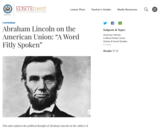
By examining Lincoln's three most famous speeches the Gettysburg Address and the First and Second Inaugural Addresses in addition to a little known fragment on the Constitution, union, and liberty, students trace what these documents say regarding the significance of union to the prospects for American self-government.

From a Smithsonian exhibition entitled "From Smithson to Smithsonian," this document relates John Quincy Adams' role in getting the US government to accept and support the gift that became the Smithsonian Institution. A transcript of Adams' report to Congress is included.
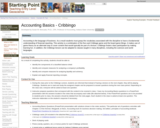
Help students grasp accounting basics, the language of business, by playing Cribbingo.

Non-profit humanitarian organization dedicated to saving lives by "eliminating hunger through prevention, detection, and treatment of malnutrition, especially during and after emergency situations of conflict, war and natural disaster".
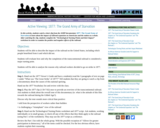
In this activity, students watch a short clip from the ASHP documentary 1877: The Grand Army of Starvationto learn about the impact of railroad expansion on Americans and the nation as a whole. After watching the clip, students complete the “Technological Turning Points and their Impact” worksheet in order to examine the positive and negative effects of the railroad.
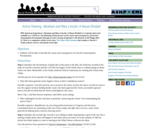
PBS American Experience’s Abraham and Mary Lincoln: A House Dividedis a 6 episode mini-series available as a 3 DVD set. The following activity focuses on the causes and consequences of Lincoln’s Emancipation Proclamation through an active viewing of Episode 4: The Dearest of All Things(Disc 2). There is a companion website to the series, The Time of the Lincolns, that contains a Teacher’s Guide, primary sources, and episode transcripts.
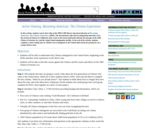
In this activity, students watch short clips of the PBS/A Bill Moyers Special production ofBecoming American: The Chinese Experience(2003). The documentary clips and accompanying materials cover the arrival of Chinese in California, their work on the transcontinental railroad, the passage of the 1882 Chinese Exclusion Act, and the Angel Island immigration facility. At the end of the activity, students complete a short writing task on whether not to immigrate to the United States from the perspective of a young Chinese man.
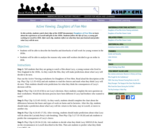
In this activity, students watch short clips of the ASHP documentary Daughters of Free Mento learn about the experiences of Lowell mill girls in the 1830s. Students follow the life of Lucy, a young girl working in Lowell in 1836. After each clip, students reflect on what they have just learned and predict what Lucy will do next.
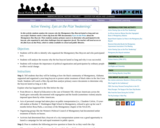
In this activity students analyze the reasons why the Montgomery Bus Boycott lasted so long and was successful. Students watch a short clip from the PBS documentary Eyes on the Prizeabout the Montgomery Bus Boycott. Then students analyze primary sources to determine who participated in the boycott, who organized it, and what challenges boycott supporters faced. The teacher will need access to the filmEyes on the Prize, which is widely available in school and public libraries.